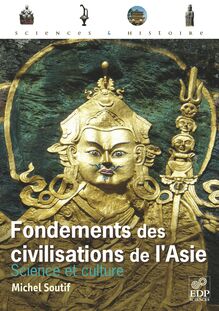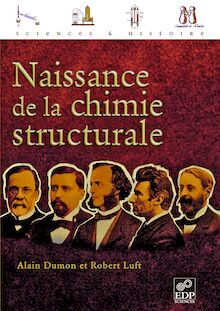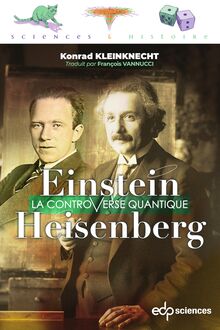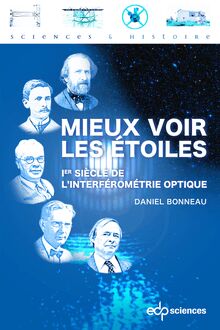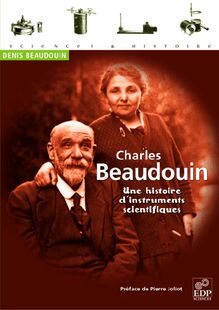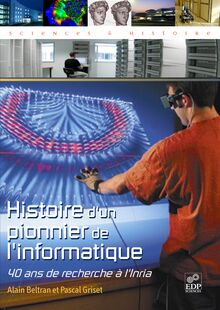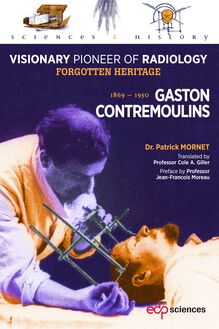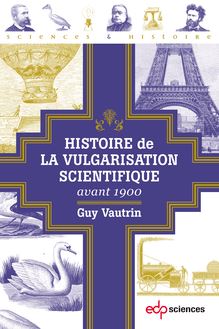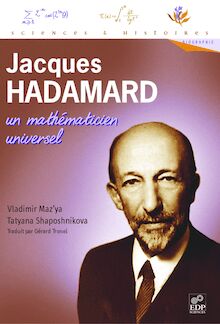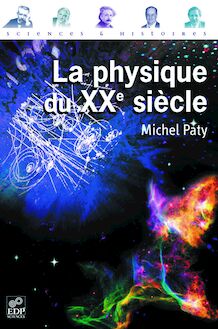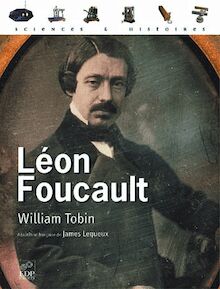Einstein’s Witches’ Sabbath and the Early Solvay Councils , livre ebook
319
pages
English
Ebooks
2021
Obtenez un accès à la bibliothèque pour le consulter en ligne En savoir plus
Découvre YouScribe en t'inscrivant gratuitement
Découvre YouScribe en t'inscrivant gratuitement
319
pages
English
Ebooks
2021
Obtenez un accès à la bibliothèque pour le consulter en ligne En savoir plus
Publié par
Date de parution
18 novembre 2021
Nombre de lectures
2
EAN13
9782759826704
Langue
English
Poids de l'ouvrage
4 Mo
BEFORE WORLD WAR II there were no regular international physics conferences, with the notable exception of seven « SOLVAY COUNCILS ». The first Council in 1911 was the result of a miraculous chain of events. Impressed by Einstein’s specific heat paper, Nernst wanted its quantum basis to be discussed by international experts. By a series of coincidences the planned « summit » was convened by Solvay, the Belgian industrialist and Maecenas. Thanks to chairman Lorentz, the meeting was so successful that to this day similar Councils have been convened by the International Physics Institute, founded by Solvay and supported by his family. Lorentz chaired five Councils that testify to the transition from classical to modern physics. The first stimulated the physicists’ interest in the quantum problem. The fifth, in 1927, solved the problem by marking, according to Heisenberg, the completion of Quantum Mechanics. The book focuses on the personal relations between the physicists who actively participated in the quantum revolution. These relations came under great strain during the Great War, but the Councils survived thanks to Lorentz’s and Solvay’s faith in the universality of science.
Publié par
Date de parution
18 novembre 2021
Nombre de lectures
2
EAN13
9782759826704
Langue
English
Poids de l'ouvrage
4 Mo
EINSTEIN’S WITCHES’ SABBATH
THE UNTOLD FRANKLIN LAMBERT
AND THE EARLY SOLVAY COUNCILS STORY AND FRITS BERENDS
EINSTEIN’S WITCHES’ SABBATH
AND THE EARLY SOLVAY COUNCILS
sciences & historyTHE UNTOLD STORY
&
historyFRANKLIN LAMBERT AND FRITS BERENDS
EFORE WORLD WAR II there were no regular Frits BerendsB international physics conferences, with the notable is emeritus professor of
exception of seven « SOLVAY COUNCILS ». theoretical physics at Leiden
University. He wrote, The frst Council in 1911 was the result of a miraculous
together with Dirk van Delft, chain of events. Impressed by Einstein’s specifc heat
a biography of Lorentz paper, Nernst wanted its quantum basis to be discussed
(in Dutch).by international experts. By a series of coincidences
the planned « summit » was convened by Solvay,
the Belgian industrialist and Maecenas. Thanks to
Franklin Lambert is chairman Lorentz, the meeting was so successful that
emeritus professor of to this day similar Councils have been convened by the
International Physics Institute, founded by Solvay and mathematical physics at
the Vrije Universiteit Brussel. supported by his family.
As a member of the Solvay
Lorentz chaired fve Councils that testify to the
Institutes he is actively involved transition from classical to modern physics. The frst
in the recovery of archival
stimulated the physicists’ interest in the quantum
documents that are scattered problem. The ffth, in 1927, solved the problem by
around the world. Together EINSTEIN’S WITCHES’marking, according to Heisenberg, the completion of
with F. Berends and M. Eckert, Quantum Mechanics.
he edited « The Early Solvay
The book focuses on the personal relations between Councils and the Advent of SABBATH
the physicists who actively participated in the quantum the Quantum Era »,
revolution. These relations came under great strain
EPJST, vol.224, 2015.
during the Great War, but the Councils survived thanks AND THE EARLY SOLVAY COUNCILS
to Lorentz’s and Solvay’s faith in the universality of
science.
THE UNTOLD STORY
FRANKLIN
LAMBERT
and
FRITS
BERENDS
45Price : €
ISBN : 978-2-7598-2669-8
www.edpsciences.org
S&H-FLambert-FBerends-GB.indd 2S&H-FLambert-FBerends-GB.indd 2 09/10/2021 09:3309/10/2021 09:33Franklin Lambert and Frits Berends
Einstein’s Witches’
Sabbath and the Early
Solvay Councils
The Untold StoryPrinted in France
© 2021, EDP Sciences , 17 avenue du Hoggar, BP 112, Parc d’activités
de Courtabœuf, 91944 Les Ulis Cedex A
This work is subject to copyright. All rights are reserved, whether the whole
or part of the material is concerned, specifically the rights of translation,
reprinting, re-use of illustrations, recitation, broad-casting, reproduction on
microfilms or in other ways, and storage in data bank. Duplication of this
publication or parts thereof is only permitted under the provisions of the
French Copyright law of March 11, 1957. Violations fall under the prosecution
act of the French Copyright law.
ISBN (print): 978-2-7598-2669-8 - ISBN (ebook): 978-2-7598-2670-4Table of Contents
Foreword 1
The first physics council 11
Chapter 1 A very unlikely “Council ” 13
1.1 A quite surprising invitation ........................... 13
1.2 Novelty of the project ................................ 15
1.3 Ernest Solvay: industrial, scientific patron and investigator ...... 17
1.4 The quantum theory ................................. 25
1.5 How Nernst discovered Einstein’s genius ................... 32
1.6 Nernst’s great dilemma ............................... 34
Chapter 2 An unprecedented project 37
2.1 The idea of a Council 37
2.2 A providential man: Ernest Solva .......................y 39
2.3 Nernst in action .................................... 41
2.4 A glimpse behind the scenes ........................... 46
2.5 Evolution of the project . . . . . . . . . . . . . . . . . . . . . . . . . . . . . . . 49
2.6 Ostwald’s project for chemistry ......................... 58
2.7 Back to the Council ................................. 63
2.8 The first Council on Physics 68
2.9 Council results ..................................... 78
Unexpected consequences of the council 93
Chapter 3 A game of musical chairs 95
3.1 Impact on Einstein’s career: from Prague to Zuric ...........h 95
3.2 The imbroglio of Lorentz’s succession ..................... 99
3.3 Second impact of the Council on Einstein’s career:
from Zurich to Berlin ................................ 107
Chapter 4 Foundation of the International Solvay Institute
for Physics 113
4.1 The Lorentz proposal 113
4.2 The Institute’s Statutes ............................... 116
4.3 Constitution of the International Scientific Committee (ISC) ..... 122
4.4 Birth of the International Institute for Physics. . . . . . . . . . . . . . . 123
IV Einstein’s Witches’ Sabbath and the Early Solvay Councils
Chapter 5 The second Physics Council 139
5.1 Members and reports ................................ 139
5.2 Highlights of “Solvay II” .............................. 140
5.3 Echoes and consequences of Solvay II ..................... 146
Chapter 6 Foundation of the International Institute
for Chemistry 149
6.1 Resuming contact with Ostwald ......................... 149
6.2 Intensification of Solvay’s work 151
6.3 The chemists and their expectations ...................... 152
6.4 Haller’s good offices ................................. 154
6.5 Solvay’s personal researc .............................h 157
6.6 Back to ISIC ...................................... 158
6.7 Impact of Ostwald’s observations ........................ 160
6.8 Haller’s master card 162
6.9 Culmination of a jubilee .............................. 163
Chapter 7 The Solvay subsidies 167
7.1 Global situation .................................... 167
7.2 How to define the order of priorities? ..................... 171
7.3 Some notable successes ............................... 176
7.4 Last measures taken by ISC before the debacle .............. 180
Impact of the Great War 183
Chapter 8 The Physics Institute survives the storm 185
8.1 First reactions to the invasion of Belgium .................. 185
8.2 The Manifesto of the 93 .............................. 188
8.3 A dead end conflict .................................. 193
8.4 Edition of the second Solvay volume: a thankless task ......... 199
8.5 Solvay’s actions and projects ........................... 201
8.6 Satisfactions, setbacks and hopes ........................ 206
8.7 Resumption of ISIP’s activities . . . . . . . . . . . . . . . . . . . . . . . . . . 212
Chapter 9 Epilogue: from “Solvay III” to “Solvay V” 219
9.1 Solvay III: Atoms and Electrons, April 1–6, 1921 ............. 219
9.2 Solvay IV: Electric Conductivity in Metals
and Related Problems, April 24–28, 1924 .................. 223
9.3 Solvay V: Electrons and Photons, October 24–29, 1927 ......... 226
9.4 Some final thoughts ................................. 238
Annexes 243
Annex 1 List of 52 Nobel laureates who took part in one
(or in several) Solvay Councils between 1911 and 1933,
or who benefitted from a Solvay research subsidy 245
Annex 2 Archival sources relating to the w orks
of Ernest Solva y 247
Annex 3 Solvay’s “Gravito-Materialitic” program 249
Table of Contents V
Annex 4 The Black-Body Problem 253
Annex 5 Planck’s “missed” Nobel Prize 255
Annex 6 The second Moroccan crisis and the Caillaux affair 257
Annex 7 Royal patronage 259
Annex 8 Essential points in the Rutherford-Thomson
confrontation 261
Bibliography 265
Acknowledgments 271
Notes 273
Index 305
Foreword
The International Institutes of Physics and Chemistry, founded by Ernest
Solvay are a unique concept in the world of science. These Institutes,
originally separated into ISIP (International Solvay Institute for physics or
International Physics Institute) and ISIC (International Solvay Institute
for Chemistry or International Chemistry Institute), were created in 1912
1and 1913 . They gave birth to the famous Solvay Councils, which were
organized periodically for more than a century.
At the time of the Institutes’ creation, international Congresses in physics
and in chemistry were very rare, unlike the situation that we know today.
2The first Congress in physics took place in Paris in 1900 . It wasn’t
followed up, as physicists didn’t feel the need for an international association.
3This state of affairs would remain unchanged until after the World War . II
Hence, we can say that the early Solvay Councils were unique, providing
regular encounters between physicists of all nationalities.
Each Council was convened for a definite purpose. It would address
current questions in physics or chemistry, identifying the most urgent problems
and opening avenues to their solution.
These specialized conferences were attended by a limited number of
participants (less than thirty during the first years) invited on account of their
expertise. Each question on the meeting’s agenda was thoroughly discussed
after an introductory report, presented by an especially competent invitee.
The Council’s reports were distributed among the members, preferably
before the meeting. The discussions, recorded by the secretaries, were
published afterwards together with the Council’s reports.
The proceedings of the early Councils are a heritage of exceptional valu
